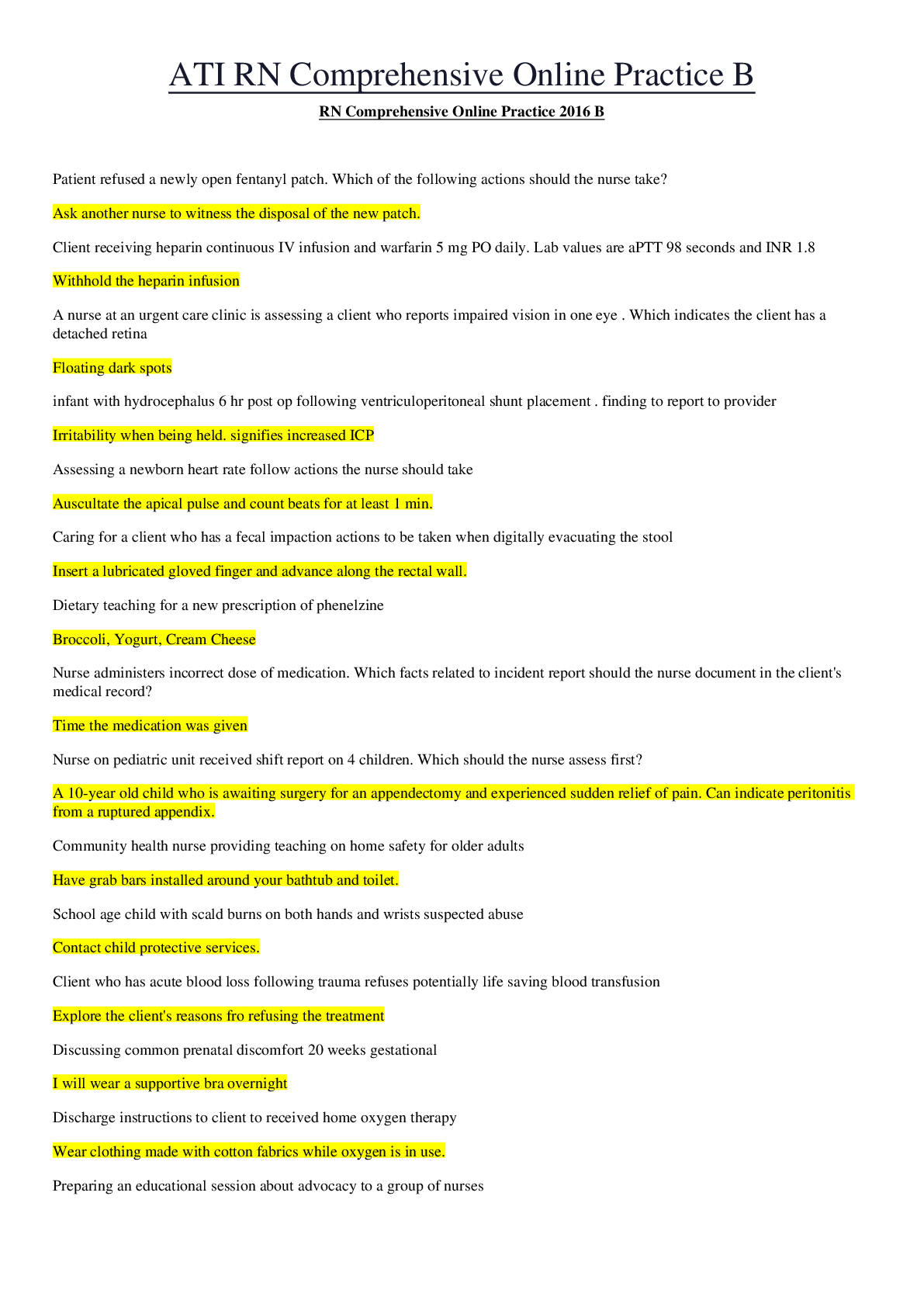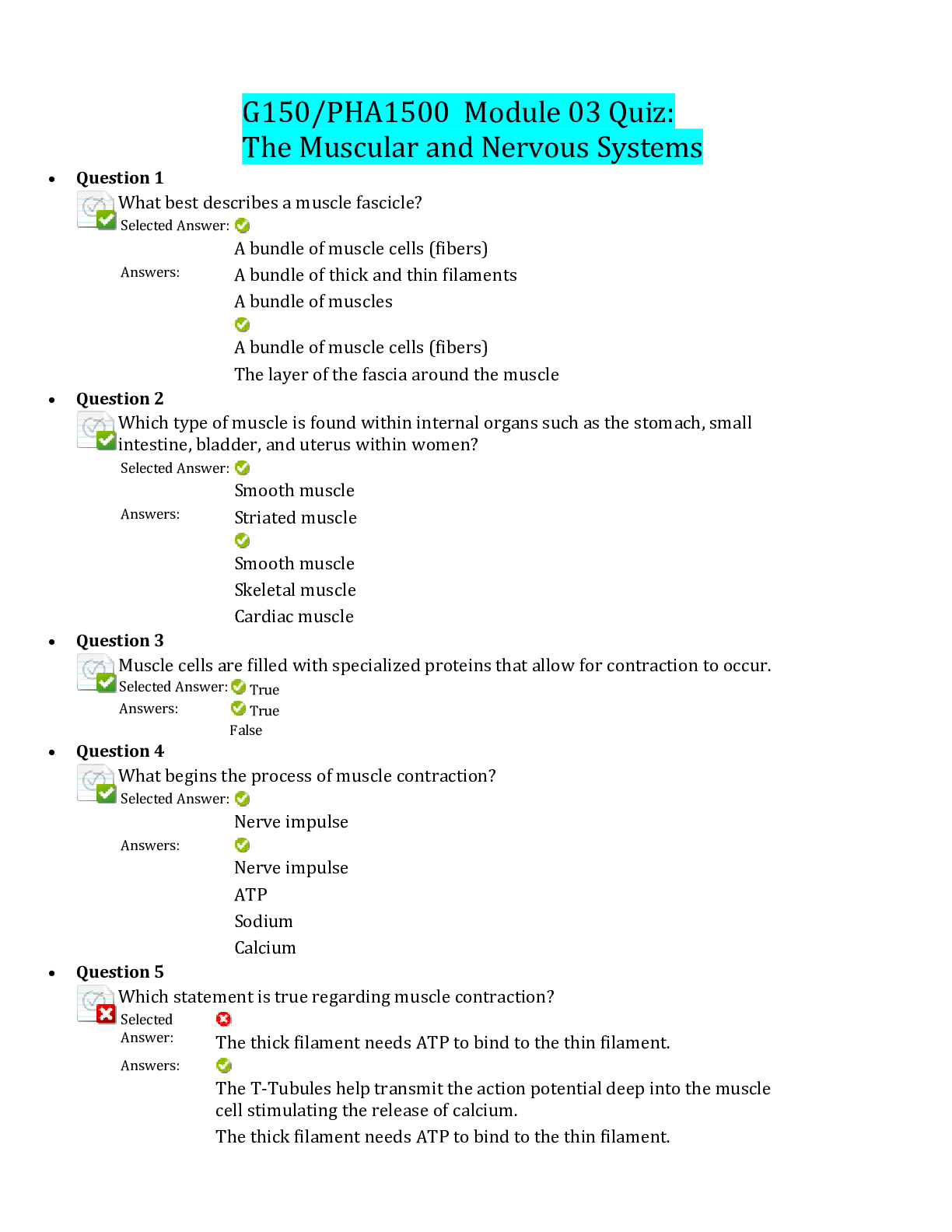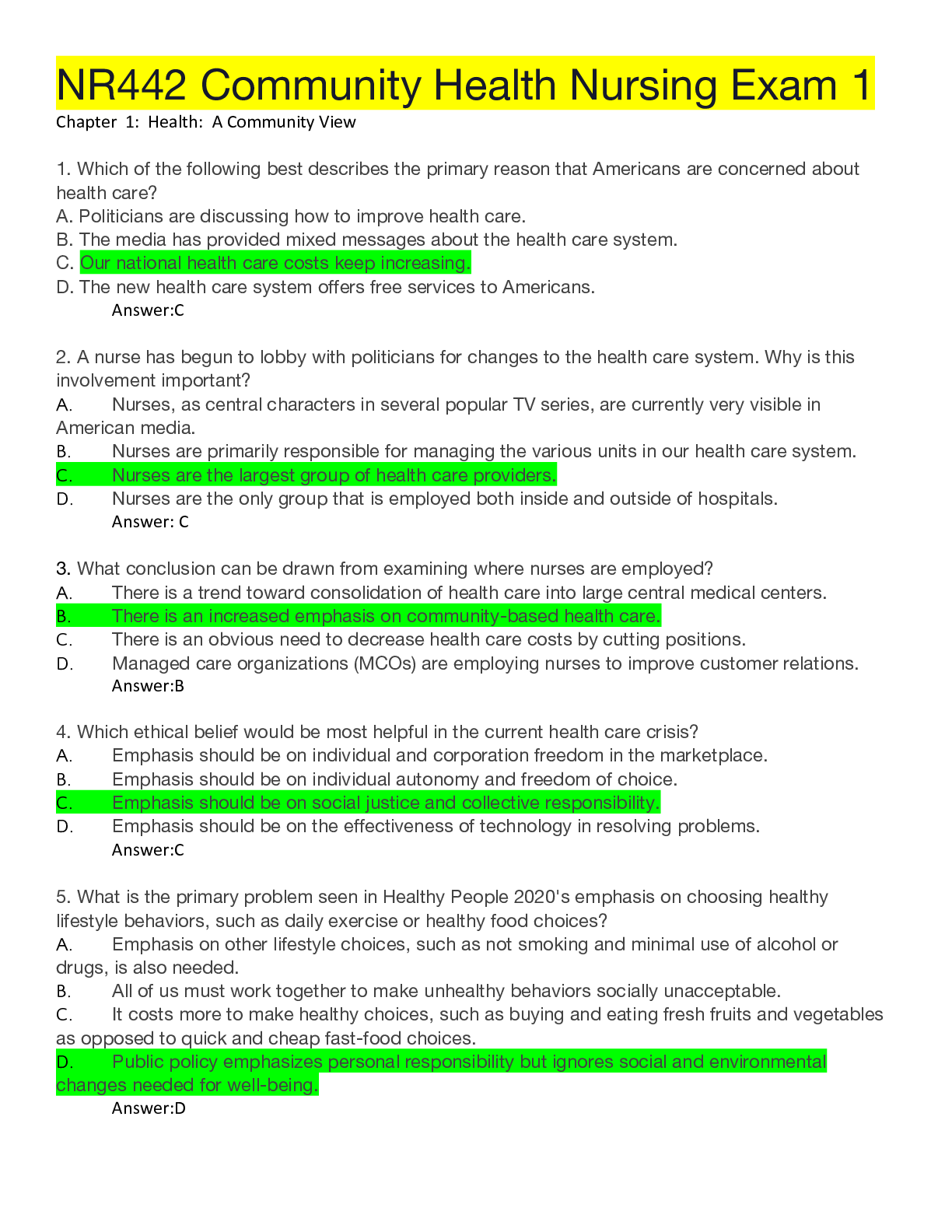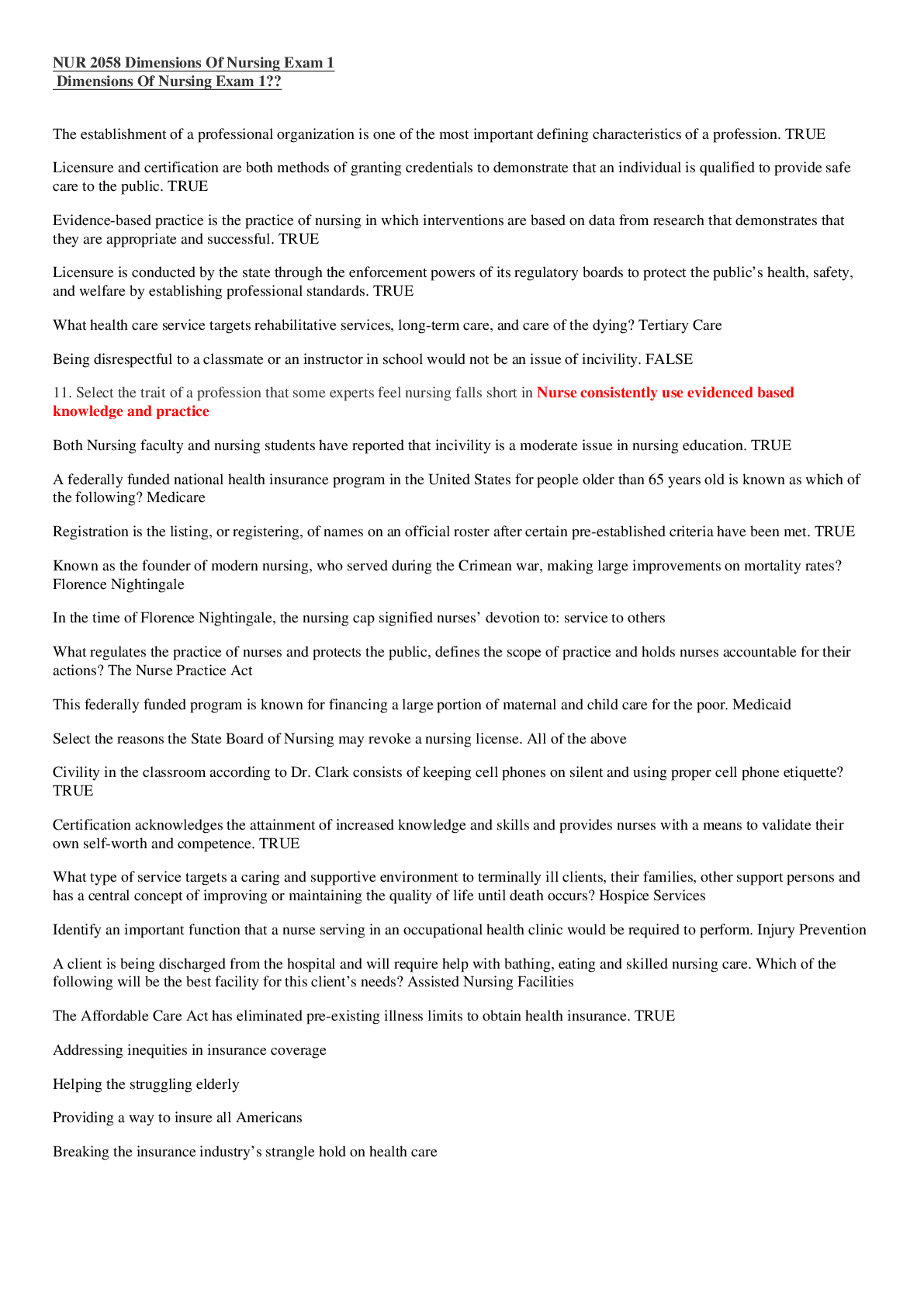*NURSING > EXAM > NUR 2115 Fundamentals of Nursing Exam 1 Study Guide (2020) – Rasmussen College | NUR2115 Fundament (All)
NUR 2115 Fundamentals of Nursing Exam 1 Study Guide (2020) – Rasmussen College | NUR2115 Fundamentals of Nursing Exam 1 Study Guide (2020)
Document Content and Description Below
NUR 2115 Fundamentals of Nursing Exam 1 Study Guide (2020) – Rasmussen College Know the different types of wellness: ϖ Wellness: an active state of being healthy, including living a lifestyle t... hat promotes good physical, mental, and emotional health. ¬ Physical Dimension: The physical dimension includes genetic inheritance, age, developmental level, race, and gender. These components strongly influence the person’s health status and health practices. ¬ Emotional Dimension: How the mind affects body functions and responds to body conditions also influences health. Long-term stress affects body systems, and anxiety affects health habits; conversely, calm acceptance and relaxation can actually change the body’s responses to illness. ¬ Intellectual Dimension: The intellectual dimension encompasses cognitive abilities, educational background, and past experiences. These influence the person’s responses to teaching about health and reactions to nursing care during illness. ¬ Environmental Dimension: The environment has many influences on health and ill- ness. Housing, sanitation, climate, and pollution of air, food, and water are elements in the environmental dimension. ¬ Sociocultural Dimension: Health practices and beliefs are strongly influenced by a per- son’s economic level, lifestyle, family, and culture. In general, low-income groups, racial and ethnic minorities, and other underserved populations are less likely to seek medical care to prevent illness and have fewer treatment options, while high-income groups are more prone to stress-related habits and illness. ¬ Spiritual Dimension: Spiritual beliefs and values are important components of a person’s health and illness behaviors (see Chapter 45). It is important that nurses respect these values and understand their importance for the individual patient. o Three spiritual needs underlie all religious traditions and are common to all people: 1. Need for meaning and purpose 2. Need for love and relatedness 3. Need for forgiveness Know the definition of culture and what it means in healthcare: ϖ Culture: a shared system of beliefs, values, and behavioral expectations that provides social structure for daily living. Culture influences roles and interactions with others as well as within families and communities, and is apparent in the attitudes and institutions unique to particular groups. ϖ Culture in Healthcare: Nurses must be aware of, and sensitive to, the needs of a diverse patient population. ¬ Physiological variation: Studies have shown that certain racial and ethnic groups are more prone to certain diseases and conditions. ¬ Reactions to pain: Health care researchers have discovered that many of the expressions and behaviors exhibited by people in pain are culturally prescribed. Some cultures allow or even encourage the open expression of emotions related to pain, whereas other cultures encourage suppression of such emotions. ¬ Mental Health: Most mental health norms originate in research and observations made of White, middle-class people. But many ethnic groups have their own norms and acceptable patterns of behavior for psychological well-being, as well as different normal psychological reactions to certain situations. ¬ Gender roles: In many cultures, the man is the dominant figure and generally makes decisions for all family members. Knowing who is dominant in the family is important when planning nursing care. ¬ Language and Communication: Linguistic competence refers to the ability of caregivers and organizations to understand and effectively respond to the linguistic needs of patients and their families in a health care encounter. o Nurses who work in a geographic area with a high popu- lation of residents who speak a language other than English should learn pertinent words and phrases in that language. o To avoid misinterpretation of questions and answers, it is important to use an interpreter who understands the health care system; friends and family members often discouraged. o One of the most culturally variable forms of nonverbal communication is eye contact. • American dominant culture emphasizes eye contact while speaking, • Direct eye contact may be considered impolite or aggressive by many Asians, Native Americans, Indochinese, Arabs, and Appalachians. • Hispanics may look downward in deference to age, gender, social position, economic status, or authority. • Muslim–Arab women often indicate modesty by avoiding eye contact with men, and Hasidic Jewish men may avoid direct eye contact with women ¬ Orientation to Space and Time: Personal space is the area around a person regarded as part of the person. When providing nursing care that involves physical contact, you should know the patient’s cultural personal space preferences. ¬ Food and Nutrition: Food preferences and preparation methods often are culturally influenced. Certain food groups serve as staples of the diet based on culture and remain so even when members of that culture are living in a different country. o Dietary teaching must be individualized according to cultural values about the social significance and sharing of food. ¬ Family Support: In many cultural and ethnic groups, people have large, extended families and consider the needs of any family member to be equal to or greater than their own. Including the family in planning care for any patient is a major component in nursing care to meet individualized needs. ¬ Socioeconomic Factors: The amount of money a person or family has affects how they meet their basic needs and maintain their health. o At highest risk are children, older people, families headed by single mothers, and the future generations of those now living in poverty. o Poverty has long been a barrier to adequate health care. It prevents many people from consistently meeting their basic human needs. ¬ Health Disparities: Health disparities refer to health differences between groups of people; they can affect how frequently a disease affects a group, how many people get sick, or how often the disease causes death. Know Asian/African American cultural preferences for health and who makes decisions: ϖ African American ¬ Family: o Close and supportive extended-family relationships o Strong kinship ties with nonblood relatives from church or organizational and social groups o Family unity, loyalty, and cooperation are important. o Usually matriarchal ¬ Folk and Traditional Healthcare: o Varies extensively and may include spiritualists, herb doc- tors, root doctors, conjurers, skilled elder family members, voodoo, faith healing. ¬ Values and Beliefs: o Present oriented o Members of the African American clergy are highly respected o Frequently highly religious ¬ Nursing Considerations: o Many African American families may still use various folk healing practices and home remedies for treating particular illnesses. o Special care may be necessary for the hair and skin. o Special consideration should be given to the sometimes extensive and frequently informal support networks of patients (e.g., religious and community group members who offer assistance in a time of need). ϖ Asian American ¬ Family: o Welfare of the family is valued above the person. o Extended families are common. o A person’s lineage (ancestors) is respected. o Sharing among family members is expected. o Patriarchal ¬ Folk and Traditional Healthcare: o Theoretical basis is in Taoism, which seeks a balance in all things. o Good health is achieved through the proper balance of yin (feminine, negative, dark, cold) and yang (masculine, positive, light, warm). o An imbalance in energy is caused by an improper diet or strong emotions. o Diseases and foods are classified as hot or cold, and a proper balance between them will promote wellness (e.g., treat a cold disease with hot foods). o Many Asian health care systems use herbs, diet, and the application of hot or cold therapy. Also, many Asians believe that there are points on the body that are located on the meridians or energy pathways. If the energy flow is out of balance, treatment of the pathways may be necessary to restore the energy equilibrium. - - - - - - - - - - - - - - - - - - - - - - - - - - - - - - - - - - - - Know S/S of infection: ϖ The signs and symptoms, identifiable in the nursing assessment, of generalized or systemic infection: ¬ Fever ¬ Presence of chills, which occur when temperature is rising, and diaphoresis, which occurs when temperature is decreasing ¬ Increased pulse and respiratory rate (in response to the high fever) ¬ Malaise ¬ Fatigue ¬ Anorexia, nausea, and vomiting ¬ Abdominal cramping and diarrhea ¬ Enlarged lymph nodes (repositories for “waste”) ϖ Older adults have a reduced inflammatory and immune response, and thus may have an advanced infection before it is identified. Atypical symptoms such as agitation, confusion, or incontinence may be the only symptom. ϖ Inflammation is the body’s local response to injury or infection. The inflammatory response has three stages. ¬ Signs and symptoms during the first stage of the inflammatory response (local infection): o Redness (from dilation of arterioles bringing blood to the area) o Warmth of the area on palpation o Edema o Pain or tenderness o Loss of use of infected area ¬ In the second stage, the micro-organisms have been killed. Fluid containing dead tissue cells and WBCs accumulates and exudate appears at the site of infection. The exudate leaves the body by draining into the lymph system. ¬ In the third stage, damaged tissue is replaced by scar tissue. Gradually, the new cells take on characteristics that are similar in structure and function to the old cells. ϖ Laboratory results indicating infection include: ¬ Leukocytosis (WBCs greater than 10,000/μL). ¬ Increases in the specific types of WBCs on differential (left shift = an increase in neutrophils). ¬ Elevated erythrocyte sedimentation rate (ESR) over 20 mm/hr. An increase indicates an active inflammatory process or infection. ¬ Presence of micro-organisms on culture of the specific fluid/area. Know what a regular heart beat is and what it’s called: ϖ The normal pulse rate for adolescents and adults ranges from 60 to 100 beats/min. ϖ The amplitude of each pulse beat is normally strong at all areas where an artery can be palpated. Know the different ways to assess body temperature: ϖ The sites most commonly used to assess body temperature are oral (sublingual), tympanic, temporal artery, rectal, and axillary. ¬ An electronic probe is placed under the tongue (sublingual area) of a person’s mouth to assess an oral temperature, in the anal canal to assess a rectal temperature, or in an axilla (armpit) to assess an axillary temperature. ¬ A probe is placed in the ear to assess a tympanic temperature. Temporal artery thermometers are swiped over the skin covering the temporal artery. [Show More]
Last updated: 2 years ago
Preview 1 out of 26 pages

Buy this document to get the full access instantly
Instant Download Access after purchase
Buy NowInstant download
We Accept:

Reviews( 0 )
$14.00
Can't find what you want? Try our AI powered Search
Document information
Connected school, study & course
About the document
Uploaded On
Jul 13, 2020
Number of pages
26
Written in
Additional information
This document has been written for:
Uploaded
Jul 13, 2020
Downloads
0
Views
123








 – University of the People.png)

















